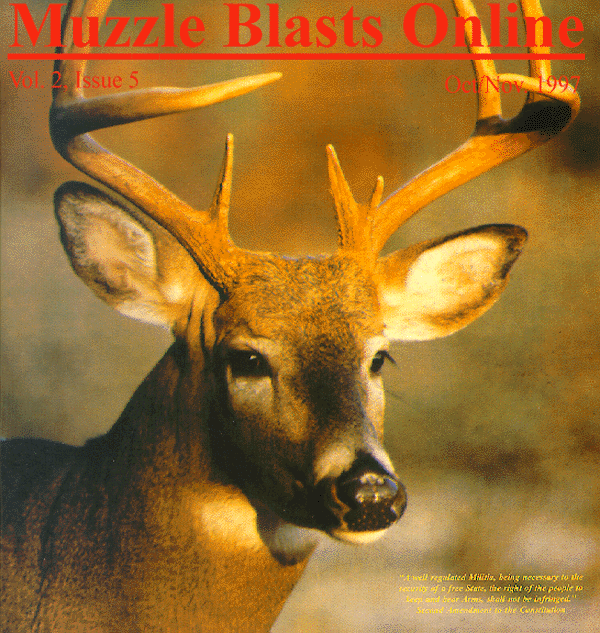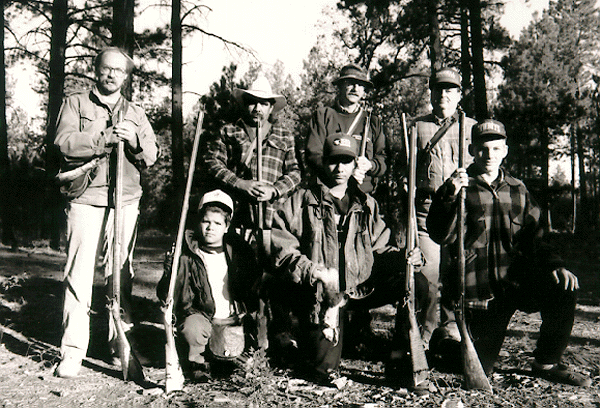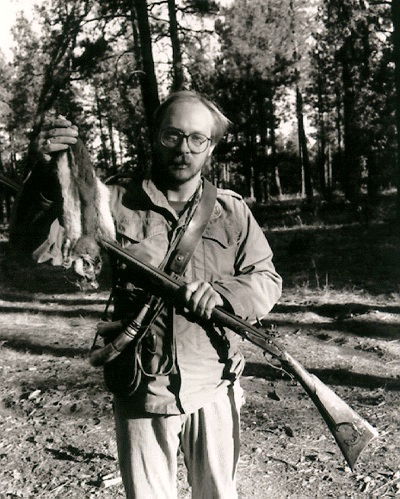|
Muzzle Blasts Online |
|
...for the muzzleloading enthusiast |
|
The muzzleblasts.com domain, subdomains, content, etc., are neither affiliated with the NMLRA nor its paper magazine Muzzle Blasts |
|
Muzzle Blasts Online |

|
|
|
|
|
|
Squirrels? ...In Arizona?
It was the opening day of the Arizona squirrel and fall turkey season. The area that we had chosen to hunt was on the Mogollon Rim at the 7500+ foot elevation. October can be pretty cold at this level. We had spent the night freezing in a shelter of sorts. I'm the type of person who thinks a black and white television in a very cheap motel is "primitive", and this was not my idea of comfort.
I was looking at the silhouettes of Ponderosa pine trees against the silver curtain of dawn and the thought passed through my mind, "!%@#!!. It's cold!"

|
After dressing in record time we loaded our flintlocks with our numb fingers. Todd asked, "Think you could call in one of those coyotes?"
"Maybe," I answered.
We headed to the end of the ridge where two canyons converge. Todd sat at the base of an uprooted tree. I picked a place about 25 yards away in front of a small pine. I had been blowing the predator call less than 30 seconds when a coyote ran across an opening below us. I started a coaxing call hoping to turn it uphill toward us. Out of the corner of my eye I saw the long barrel of Todd's flintlock pointing downhill. The crack of the rifle shot echoed down the canyon. I continued to call because many times I have called in multiple animals on the same stand. After about 15 minutes I walked over to Todd and asked, "Did you get him?"
"Yeah," he replied, pointing at the dead coyote about twenty yards away. This was his first kill with a muzzleloader. To say he was excited would be an understatement. Two coyotes had answered the call. The coyote that I had seen was spooked but the other one came straight up the hill towards Todd. Earlier I had told Todd to let the animals come as close as possible to ensure an effective shot.
I took Todd's rifle and told him to retrieve his trophy. He held up a big male coyote and I jokingly said, "Uh-Oh! You just shot Rin-Tin-Tin."
Lowering the coyote, Todd looked up at me, "Nawww! It's a coyote....isn't it?"
"It's really a coyote," I assured him. "You saved a few turkeys and fawns with that shot. Where did you hit him?"
"In the head."
I must have had a stunned look on my face because he asked, "Is that okay...where should I have hit him? You said head shots only."
"You did fine, Todd, just fine."
"The other guys aren't going to believe this." I thought he'd actually hit the coyote between the eyes. The "head-shots only" statement was in reference to shooting squirrels. We took the coyote with us to skin out later.
So began our annual Arizona muzzleloading squirrel hunt. For the past several years I have invited some muzzleloading friends to hunt squirrels with me. I encourage fathers to bring their sons with them. The hunt is intended to be a social outing and not a rendezvous. We camp together but divide up into twos or threes to hunt. The rules are simple. First and foremost are safety and hunting ethics. Head shots only; we don't keep score; and we have a good time.
Squirrels?...In Arizona? This arid state of desert and cactus offers a variety of tree squirrels that is unmatched by any other state in the U.S.! Arizona has three species of tassel ear squirrels, four species of fox squirrels and two species of red (pine) squirrels. This is due to the variety and isolation of Arizona forests. The most popular hunted species is the tassel ear Abert squirrel. The Abert squirrel inhabits pine forests at elevations of 5000 to 8500 feet. Arizona grey squirrels, a species of fox squirrel, are hunted by a few people. The greys inhabit the riparian deciduous forests at elevations of 3500 to 7500 feet. The population density of the grey squirrel is not really known, but at one time greys were considered to be the rarest of the Arizona mammals. There are areas where the "Greys" are somewhat numerous.
Abert squirrels are most often seen running on the ground. When they get into a tree they can disappear faster than a cupcake at a diet convention. The Abert has many tricks to elude the hunter. Many times the Abert will climb about five feet up the trunk, then scoot around to the other side and jump off. Putting the tree between the hunter and himself, he will then climb another tree. Once he is in a tree he will flatten out on a limb, curl up in a bunch of pine needles, or climb to the very tip of the tallest pine tree and look at you over top of the needles with only his eyes and tasseled ears showing.
The Abert squirrel has a charcoal-grey body with a rust colored patch on the back between its shoulders. The underside of the body and the tail are very white. Another feature is the one-inch long tufts of hair at the end of the ears. The Abert is a very handsome animal. These squirrels are very good at hiding in plain sight and are extremely patient. Once after a three-day rendezvous, when most people had left, I observed an Abert squirrel descending a small pine tree right in the middle of the campsite. It hit the ground running and left the area. I believe that the squirrel had been in that small tree for three or four days, unobserved.
The Abert does not share the same habits as the eastern greys or fox squirrels. Getting into the woods at the crack of dawn to hunt them is a waste of time. The Abert prefer to wait for the sun to warm things up before they start foraging. Their food is primarily the tender buds on the end of Ponderosa pine branches. They will eat pine seeds, mushrooms, berries and acorns. Their food does not affect the flavor of the meat. The Aberts taste the same as their eastern cousins: sweet and tender if they are young. The older squirrels are like the eastern fox squirrel, tougher than saddle leather. You can bend a fork on the gravy.
Two methods are used in hunting Abert squirrels. One is to drive the logging roads until one is spotted running on the ground, and then try to chase it up a tree for a shot. You can put a lot of miles on your vehicle before you get a limit. The other is to hunt along the ridges slowly and quietly. I like this method best. As I noted before, the squirrels are somewhat shy and are very difficult to spot in the pine trees. Binoculars are a must for locating them in the thick foliage.
The sun had removed the cold bite of morning as we headed back to camp. We had seen a few squirrels, but they had outsmarted us. A nice five-point bull elk and his harem of cows crossed the road and then faded into the timber. The sunshine was illuminating the fall colors of the maples, oaks, aspens, and other trees. It was going to be a great weekend.
By the time we returned to camp, a few others had arrived. Terry Riley with his son, Brian, and Carlos Hernandez, with his sons Carlos Jr. and Alex, had been there. They had dumped their camping gear on the ground and gone into the woods in search of the elusive quarry. Jeff Murray drove into camp a few minutes after we arrived. We had a little food and drink and were ready to go again. After driving to another location, Todd and I went one direction and Jeff the other. Todd still hunted the top of the ridge and I moved down to the bottom. I saw an Abert moving below me on the ground. I slipped down the ridge and sat for a while. The squirrel had disappeared. This was a common scenario while hunting Arizona squirrels.
Slowly hunting along the ridge, I saw a squirrel on the ground going uphill. With Todd hunting the top of the ridge, I would not risk a shot while the squirrel was on the ground. I followed the squirrel and lost it. I was trying to locate it in the trees when Todd asked. "See anything?" He had not seen the squirrel on the ground. We sat down trying to locate the squirrel in the trees. After a while Todd moved and the squirrel barked right above him. I rested my .32 caliber flintlock against a small pine. I held the sights right on the head and squeezed the trigger for a perfect shot just below the ear.
As planned, we met Jeff about an hour later. We went to another area that had been logged over. Todd collected the next squirrel. It was about forty feet up in a tall Ponderosa pine. After backing down the hill to get a better view of the squirrel, he rested his .45 caliber flintlock against a tree and made another perfect head shot. We all saw squirrels and collected a few.
We take turns with the shots. There is no "me first" or competition for who gets the most squirrels. Jeff was next and he had an almost vertical shot at a squirrel's head. Jeff's load of 50 grains of 3F behind the little .32 caliber ball literally launched the squirrel off the limb. The three of us hunted for the remainder of the day with moderate success.
We arrived back at camp at dusk. I showed the boys how to clean a squirrel and then turned the job over the them. Todd and I proceeded to skin the coyote he had shot that morning.
It was time to eat, socialize and tell stories. Carlos had made a pot of thermonuclear chili beans. The beans were on a par with napalm. Carlos likes his food hot!!! After a bowl of these beans with some tortillas we did not pay much attention to the cold that was enveloping us. We finished the meal off with cold drinks and a handful of antacid tablets for dessert. Carlos' cure for third-degree burns of the tongue and throat from Mexican food is to eat a spoonful of sugar. I wished I had some.
The stories began as we sat around the warmth of an oak fire in my sheep herder's stove. All of us had tales about our good shots and about how fast a squirrel can disappear. There were a few missed shots during the day. Terry told how he and Carlos had fired several "warning" shots at one squirrel before they finally scared it off. They were afraid one of the boys might hit it. I asked the youngsters if any of them had made a less than perfect shot on any squirrels. One started laughing and pointed to his dad. The dad muttered something about "It was a good shot, the head was just on the wrong end." The stories degenerated from that point.
Everyone had seen numerous deer and elk. Two days earlier my wife Elaine and I had seen a black bear about a mile up the road. Early this morning Terry and Brian, who didn't have a valid turkey tag, had seen a flock of turkeys feeding up a draw.
All the young men are well mannered and a pleasure to have in camp. They didn't act like stereotypical teenagers. Carlos will be taking Carlos Jr. on his first deer hunt this year--a muzzleloading deer hunt, no less. The only rifle that Brian Riley has ever shot is a muzzleloader. Terry made a .40 caliber rifle for Brian and he can shoot with the best of us. These dads are teaching their sons right.
The next morning was just as cold as the previous one. Everyone huddled around the sheep herder's stove for warmth. Breakfast consisted of hot coffee or chocolate, blueberry muffins, and another handful of antacid tablets. We soon started drifting off in groups to hunt again. Terry and Carlos loaded up the boys in the trucks and headed for the rim road.
Jeff, Todd, and I headed back to the area we had hunted the day before. As we were driving, an Abert squirrel ran across the road and climbed a very tall ponderosa pine. We quickly parked and grabbed our guns, pouches, horns, and all the other stuff that is required to shoot at a squirrel. We quickly loaded our guns and tried to locate the squirrel. After several minutes of glassing we found it up thirty feet or more in the tree, stretched out on a limb. I backed up to get a better view of the squirrel. Again, I rested the rifle against the side of a tree and held on the squirrel's head. The squirrel was lying on the limb looking down at us. I was sure of the shot, and when the rifle cracked, the squirrel flipped over and fell about ten feet through the limbs. But it grabbed a limb with its forefeet and was trying to climb onto it.
Todd said "you hit it, I saw stuff fly off it."
"I think you hit the limb. It looked like pieces of wood flew off." Jeff added. "Load up and we will watch him for you."
I had just finished loading and was aiming for the second shot when the squirrel let go of the limb and hit the ground. I picked the squirrel up expecting to find a hole in the midsection. But to my surprise there was not a hole in it. Just a streak across the chest between the forelegs. The shot didn't even break the skin. In my forty-plus years of hunting I had finally "barked" my first squirrel. Although it was not deliberate I said, "Well guys, that's how you bark a squirrel." After all the cat calls and laughter died down we continued our hunt.
Todd and Jeff went in one direction and I took off in the opposite direction. The bottom of the ridge that I was hunting was covered with thick brush. Both mountain lion and bear were in season. This looked like an ideal place to call. I sat by a fallen log with a good view for about forty yards around and proceeded to blow my predator call. My second-favorite hunting is predator calling. My first is squirrel hunting with a muzzleloader.
The anticipation of one of these great creatures charging out of the brush had an overdose of adrenaline pulsing through my body. I started to check the priming in my flintlock and a cold chill came over me as I stared at the .32 caliber with its anemic load of 18 grains of powder. I scrambled to my feet, saying "Oh sugar!" or something like that. I left the area rather quickly. I made as much noise as I could to discourage anything that might have been sizing me up for lunch.
The evening was coming on fast. It was another good day of hunting. I was walking back toward the truck when I came upon Jeff and Todd arguing about something.
"It was a nine, I tell you." Jeff said.
"Naw. I would have scored it a seven," Todd countered.
I knew that squirrels were not listed in either the Longhunter or the Boone and Crockett record books. I was curious about what was going on...I had to ask...Jeff had taken a shot at a squirrel and had buzzed its ear. The shot was too close for comfort and the squirrel decided it was time to leave. It jumped out of the top of a very tall pine and hit the ground running. They lost it...
"I say it was a 9, Todd." Jeff argued.
"It didn't do a flip or a twist, so I just give it a 7. It was a nice swan dive though."

|
We were about a hundred yards away when the cows started walking down the ridge. A huge six-point bull walked out in front of us and issued another challenge. He then walked into the timber, following his harem. We sat for a while listening to the bull elk bugling around us.
My father told me, "success is not measured by the number of animals you kill but in the memories that you have of the hunt." Squirrel hunting was his favorite too, and we had many great times together. Our last hunting trip together was for squirrels.
Squirrel hunting in Arizona is very challenging and rewarding in more ways than one. The limit is five squirrels per day with ten in possession. Squirrel gun calibers like the .32,.36,.38 and .40 calibers are the most common ones used by our group of hunters. Turkey, bear, and mountain lion are in season, but you must have a valid Arizona big game tag for those species.
The variety of animals that are encountered makes the hunt a thrill: elk, mule deer, whitetail (Coues') deer, turkeys, coyotes, fox, bobcats, and black bear. Mountain lion and a host of small game inhabit Arizona squirrel country. There is an abundance of fabulous scenery also. Be sure to take a camera along with you.
For information on Arizona hunting regulations, contact the Arizona Game and Fish Department at (602) 942-3000.